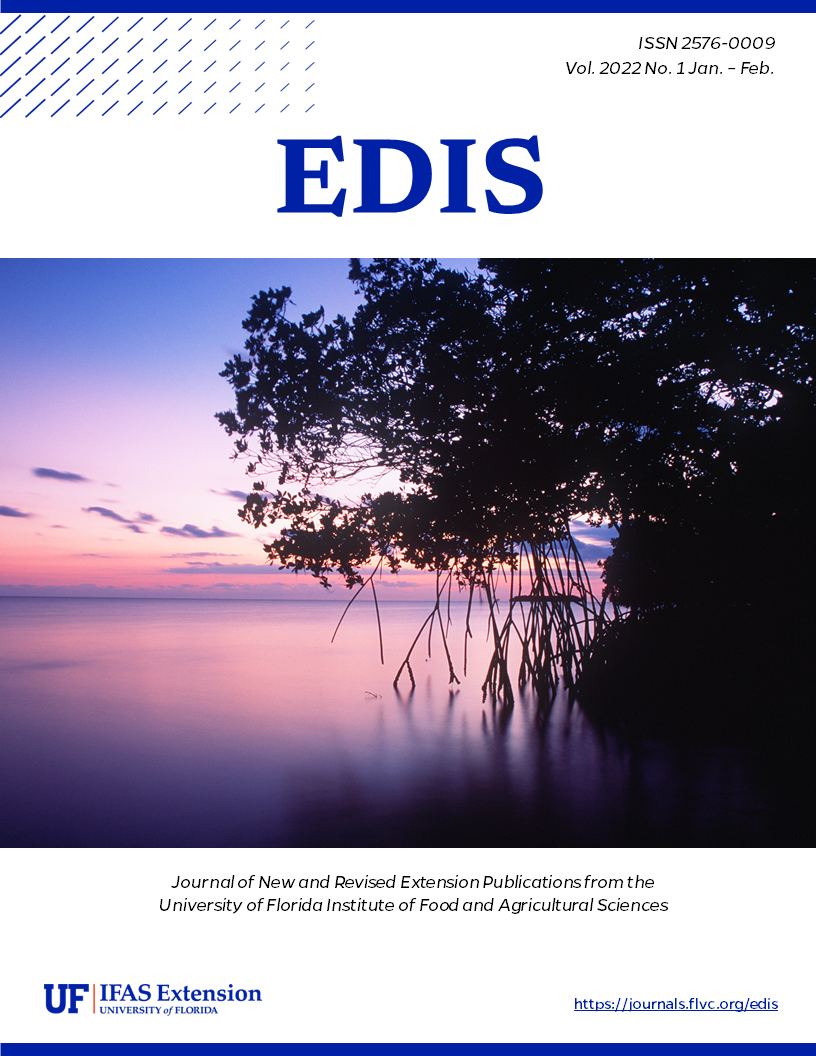Abstract
Urban mangroves are mangroves located in cities and residential areas. While urban mangroves may be highly impacted by humans, they continue to provide important ecosystem services, or benefits to society. In fact, due to their location, more people may benefit from these urban mangroves than from pristine mangroves, which are often located in protected areas. The following document describes the role of mangroves in urban areas. This document is intended for coastal residents, coastal resource managers, and urban planners who are interested in learning about mangroves and their importance in cities. Written by Gabriela Reyes, Ashley Smyth, and Laura Reynolds, and published by the UF/IFAS Department of Soil and Water Sciences; 4 pp.
https://edis.ifas.ufl.edu/ss706
References
Branoff, B. L. 2017. “Quantifying the Influence of Urban Land Use on Mangrove Biology and Ecology: A Meta-analysis.” Global Ecology and Biogeography 26 (11): 1339–1356. https://doi.org/10.1111/geb.12638
Bureau of Business and Economic Research. 2020. “Population Studies Program.” https://www.bebr.ufl.edu/population
Currin, C. A. 2019. “Living Shorelines for Coastal Resilience.” In Coastal Wetlands, Second Edition, edited by G. M. E. Perillo, E. Wolanski, D. R. Cahoon, and C. S. Hopkinson, 1023–1053. Elsevier. https://doi.org/10.1016/B978-0-444-63893-9.00030-7
Duke, N., I. Nagelkerken, T. Agardy, S. Wells, and H. van Lavieren. 2014. The Importance of Mangroves to People: A Call to Action. Edited by J. van Bochove, E. Sullivan, and T. Nakamura. Cambridge: United Nations Environment Programme World Conservation Monitoring Centre.
Erwin, K. L. 2009. “Wetlands and Global Climate Change: The Role of Wetland Restoration in a Changing World.” Wetlands Ecology and Management 17 (1): 71–84. https://doi.org/10.1007/s11273-008-9119-1
Goldberg, L., D. Lagomasino, N. Thomas, and T. Fatoyinbo. 2020. “Global Declines in Human‐Driven Mangrove Loss.” Global Change Biology 26 (10): 5844–5855. https://doi.org/10.1111/gcb.15275
Krebs, J. M., S. S. Bell, and C. C. McIvor. 2014. “Assessing the Link between Coastal Urbanization and the Quality of Nekton Habitat in Mangrove Tidal Tributaries.” Estuaries and Coasts 37:832–846. https://doi.org/10.1007/s12237-013-9724-y
Lefcheck, J. S., B. B. Hughes, A. J. Johnson, B. W. Pfirrmann, D. B. Rasher, A. R. Smyth, B. L. Williams, M. W. Beck, and R. J. Orth. 2019. “Are Coastal Habitats Important Nurseries? A Meta‐analysis.” Conservation Letters 12 (4): e12645. https://doi.org/10.1111/conl.12645
MacFarlane, G. R., and M. D. Burchett. 2002. “Toxicity, Growth and Accumulation Relationships of Copper, Lead and Zinc in the Grey Mangrove Avicennia marina (Forsk.) Vierh.” Marine Environmental Research 54 (1): 65–84. https://doi.org/10.1016/S0141-1136(02)00095-8
Narayan, S., M. W. Beck, B. G. Reguero, I. J. Losafa, B. van Wesenbeeck, N. Pontee, J. N. Sanchirico, J. C. Ingram, G.-M. Lange, and K. A. Burks-Cope. 2016. “The Effectiveness, Costs and Coastal Protection Benefits of Natural and Nature-Based Defences.” PLoS ONE 11 (5): e0154735. https://doi.org/10.1371/journal.pone.0154735
Pickett, S. T. A., M. L. Cadenasso, J. M. Grove, C. H. Nilon, R. V. Pouyat, W. C. Zipperer, and R. Costanza. 2001. “Urban Ecological Systems: Linking Terrestrial Ecological, Physical, and Socioeconomic Components of Metropolitan Areas.” Annual Review of Ecology and Systematics 32:127–157. https://doi.org/10.1146/annurev.ecolsys.32.081501.114012
Polidoro, B. A., K. E. Carpenter, L. Collins, N. C. Duke, A. M. Ellison, J. C. Ellison, E. J. Farnsworth, E. S. Fernando, K. Kathiresan, N. E. Koedam, S. R. Livingstone, T. Miyagi, G. E. Moore, V. Ngoc Nam, J. E. Ong, J. H. Primavera, S. G. Salmo, J. C. Sanciangco, S. Sukardjo, Y. Wang, and J. W. H. Yong. 2010. “The Loss of Species: Mangrove Extinction Risk and Geographic Areas of Global Concern.” PLoS ONE 5 (4): e10095. https://doi.org/10.1371/journal.pone.0010095
US Fish and Wildlife Service Southeast Region. (1999). South Florida Multi-Species Recovery Plan – Ecological Communities: Mangroves [White paper]. https://www.nrc.gov/docs/ML1219/ML12193A340.pdf
Worthington, T., and M. Spalding. 2018. Mangrove Restoration Potential: A Global Map Highlighting a Critical Opportunity. The Nature Conservancy Report. https://doi.org/10.17863/CAM.39153

